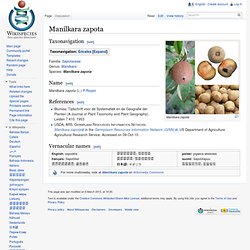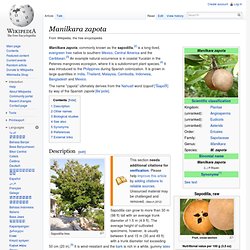

Sapotille. Natif des régions chaudes et humides d’Amérique Centrale et du sud du Mexique, le sapotillier gagne rapidement le reste de l’Amérique tropicale et les Antilles puis, à l’époque des colonies, l’Afrique, l’Asie et les zones sub-tropicales du globe.

L’arbre entier contient un latex blanc. De ce latex, connu des Mayas qui l’utilisaient en gomme à mâcher, on a longtemps extrait le chicle, base de la fabrication du chewing-gum. Bel arbre à cime arrondie et aux branches inférieures horizontales, il peut atteindre 25 m de haut. Les feuilles ovales-elliptiques se groupent à l’extrémité des branches. La petite fleur blanche et solitaire naît à l’aisselle de la feuille.
Famille : Sapotacées Nom de l'arbre : Sapotillier Floraison : Presque toute l’année Fructification : Presque toute l’année Dimension du fruit : 3 à 8 cm de long Autres noms : Sapodilla (en) ; Sapotilla (es) ; Sapoti (créole) 10 MORE Must-try exotic fruits. Since our 10 Must-try Exotic Fruits was so well-received by you, our readers, we decided to look for some more healthy and delicious fruits that you absolutely must try if you ever have the chance, and here’s what we have on the menu for you: 10.

Ugli Ugli is a citrus hybrid between grapefruit and tangerine that grows in Jamaica. Its weird name may be spelled wrong but it really comes from “ugly†in reference to its unappealing, wrinkled skin. But the looks of the Ugli have nothing to do with the taste, it is incredibly delicious and juicy, it takes more from the sweet tangerine and less from the sour grapefruit. As a curiosity, you should know Ugli is the only fruit in the world that starts with the letter U. Photo credits 9. Langsat is an egg-shaped fruit, about 5 centimeters in diameter, usually found in clusters of two to thirty fruits. Photo credits 8. Photo credits 7. When picking out Guava fruits, check if they’re ripe, that’s when they taste the best. Photo credits 6. 5. 4. Manilkara zapota. Manilkara zapota [edit] Familia: Sapotaceae Genus: Manilkara Species: Manilkara zapota Name[edit] Manilkara zapota (L.)

P.Royen References[edit] Blumea; Tijdschrift voor de Systematiek en de Geografie der Planten (A Journal of Plant Taxonomy and Plant Geography). Vernacular names[edit] English: sapodillafrançais: Sapotillierગુજરાતી: ચીકુहिन्दी: चीकूमराठी: चिक्कू日本語: サポジラpolski: pigwica właściwasuomi: Sapotillapuuతెలుగు: సపోట. Manilkara zapota. Manilkara zapota, commonly known as the sapodilla,[2] is a long-lived, evergreen tree native to southern Mexico, Central America and the Caribbean.[3] An example natural occurrence is in coastal Yucatán in the Petenes mangroves ecoregion, where it is a subdominant plant species.[4] It was introduced to the Philippines during Spanish colonization.

It is grown in large quantities in India, Thailand, Malaysia, Cambodia, Indonesia, Bangladesh and Mexico. The name "zapota" ultimately derives from the Nahuatl word tzapotl [ˈt͡sapot͡ɬ] by way of the Spanish zapote [θaˈpote]. Description[edit] Sapodilla can grow to more than 30 m (98 ft) tall with an average trunk diameter of 1.5 m (4.9 ft). The average height of cultivated specimens, however, is usually between 9 and 15 m (30 and 49 ft) with a trunk diameter not exceeding 50 cm (20 in).[5] It is wind-resistant and the bark is rich in a white, gummy latex called chicle. The fruit has an exceptionally sweet, malty flavor. Other names[edit] Sapote.